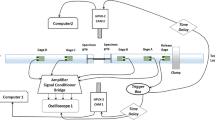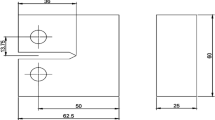Abstract
This paper investigates modifications to the Brazilian disk and compact tension C(T) standard test geometries to allow full-field extraction of elastic tensile and toughness properties. A central notch has been introduced in the Brazilian disk to allow for the extraction of fracture properties, while the C(T) sample has been lengthened to allow for the extraction of tensile properties. Full-field displacements, measured on samples prepared from PMMA (Polymethyl methacrylate) using digital image correlation are analysed under the assumption of linear elasticity. First, the Virtual Fields Method is applied to estimate Young’s Modulus (E) and Poisson’s Ratio (v). These tensile properties are then used to determine estimates for the peak stress intensity factor (SIF) prior to fracture through a non-linear least squares field fitting approach. Test results show that a modified disk sample performed well in both analysis approaches with relative errors obtained as: 2.1% in E, 12.9% in v and 1% in SIF. A modified C(T) sample obtained relative errors of: 1.5% in E, 40.2% in v and 1% in SIF. Furthermore it is shown that field fitting approaches are less sensitive to error in v than error in E. The presented evidence aims to guide future experiments utilizing full-field techniques to study material properties in the framework of fracture mechanics, in particular in applications where limited material for obtaining tensile properties is available.












Similar content being viewed by others
Notes
The code was adapted with permission by Matthew Molteno of Stellenbosch University for 2D and 3D DIC.
References
Grédiac M, Pierron F, Avril S, Toussaint E (2006) The virtual fields method for extracting constitutive parameters from full-field measurements : a review. Strain 42:233–253
Pierron F, Grédiac M (2012) The virtual fields method: extracting constitutive mechanical parameters from full-field deformation measurements. Springer
Sutton MA, Orteu J-J, Schreier HW (2009) Image correlation for shape, motion and deformation measurements: basic concepts, theory and applications. Springer, New York
Grédiac M, Pierron F (2006) Applying the virtual fields method to the identification of elasto-plastic constitutive parameters. Int J Plast 22:602–627. https://doi.org/10.1016/j.ijplas.2005.04.007
Mcneill SR, Peters WH, Sutton MA (1987) Estimation of stress intensity factor by digital image correlation. Eng Fract Mech 28:101–112
Becker TH, Mostafavi M, Tait RB, Marrow TJ (2012) An approach to calculate the J -integral by digital image correlation displacement field measurement. Fatigue Fract Eng Mater Struct 35:971–984. https://doi.org/10.1111/j.1460-2695.2012.01685.x
Yoneyama S, Morimoto Y, Takashi M (2006) Automatic evaluation of mixed-mode stress intensity factors utilizing digital image correlation. Strain 42:21–29. https://doi.org/10.1111/j.1475-1305.2006.00246.x
Yoneyama S, Ogawa T, Kobayashi Y (2007) Evaluating mixed-mode stress intensity factors from full-field displacement fields obtained by optical methods. Eng Fract Mech 74:1399–1412. https://doi.org/10.1016/j.engfracmech.2006.08.004
Yoneyama S, Arikawa S, Kusayanagi S, Hazumi K (2014) Evaluating J-integral from displacement fields measured by digital image correlation. Strain 50:147–160. https://doi.org/10.1111/str.12074
Molteno MR, Becker TH (2015) Mode I – III decomposition of the J -integral from DIC displacement data. Strain 51:492–503. https://doi.org/10.1111/str.12166.M.
Lyons JS, Liu J, Sutton MA (1996) High-temperature Deformation Measurements Using Digital-image Correlation. 64–70
Grant BMB, Stone HJ, Withers PJ, Preuss M (2009) High-temperature strain field measurement using digital image correlation. 44:263–271. https://doi.org/10.1243/03093247JSA478
Chen X, Xie X, Sun J, Yang L (2012) Full field strain measurement of punch-stretch tests using digital image correlation. SAE Int J Mater Manuf 5:345–351. https://doi.org/10.4271/2012-01-0183
Avril S, Pierron F (2007) General framework for the identification of constitutive parameters from full-field measurements in linear elasticity. Int J Solids Struct 44:4978–5002. https://doi.org/10.1016/j.ijsolstr.2006.12.018
Avril S, Pierron F, Pannier Y, Rotinat R (2008) Stress reconstruction and constitutive parameter identification in plane-stress elasto-plastic problems using surface measurements of deformation fields. Exp Mech 48:403–419. https://doi.org/10.1007/s11340-007-9084-2
ASTM E399-09 (2010) Standard test method for linear-elastic plane-strain fracture toughness KIc of metallic materials. https://doi.org/10.1520/E0399-09E02.2
ASTM E8/EM–11 (2015) Standard Test Methods for Tension Testing of Metallic Materials. https://doi.org/10.1520/E0008
Becker TH, Marrow TJ, Tait RB (2011) Damage, crack growth and fracture characteristics of nuclear grade graphite using the double torsion technique. J Nucl Mater 414:32–43. https://doi.org/10.1016/j.jnucmat.2011.04.058
Rossi M, Fardmoshiri M, Sasso M, Amodio D (2013) Application of the virtual fields method to fracture mechanics. Convegno Natl IGF XXI ROMA 322–331.
Mascia L (1982) Thermoplastics: materials engineering. Applied Science Publishers, Essex
Kuna M (2013) Finite elements in fracture mechanics. Springer
Mokhtarishirazabad M, Lopez-Crespo P, Moreno B et al (2016) Evaluation of crack-tip fields from DIC data: a parametric study. Int J Fatigue 89:11–19. https://doi.org/10.1016/j.ijfatigue.2016.03.006
Opto Engineering (2015) Technical Specification: TC13036 Bi-Telecentric Lens. http://www.opto-engineering.com/media/pdf/TC13036-datasheet-en.pdf. Accessed 14 Dec 2016
Avril S, Grediac M, Pierron F (2004) Sensitivity of the virtual fields method to noisy data. Comput Mech 34:439–452. https://doi.org/10.1007/s00466-004-0589-6
Rossi M, Lava P, Pierron F et al (2015) Effect of DIC spatial resolution, noise and interpolation error on identification results with the VFM. Strain 51:206–222. https://doi.org/10.1111/str.12134
Badaloni M, Rossi M, Chiappini G et al (2015) Impact of experimental uncertainties on the identification of mechanical material properties using DIC. Exp Mech 55:1411–1426. https://doi.org/10.1007/s11340-015-0039-8
Acknowledgements
The authors disclosed receipt of the following financial support for the research, authorship, and publication of this article: This work is based on the research supported in part by the National Research Foundation of South Africa for the grant, Unique Grant No. 87955 and 106932, and in part by the ESKOM Power Plant Engineering Institute (EPPEI) Material Science Specialisation programme.
Author information
Authors and Affiliations
Corresponding author
Rights and permissions
About this article
Cite this article
Huchzermeyer, R.L., Becker, T.H. The Application of Full-Field Techniques to Estimate both Tensile and Fracture Properties: an Investigation into Modifications to Standard Sample Geometries. Exp Tech 42, 671–683 (2018). https://doi.org/10.1007/s40799-018-0267-9
Received:
Accepted:
Published:
Issue Date:
DOI: https://doi.org/10.1007/s40799-018-0267-9




